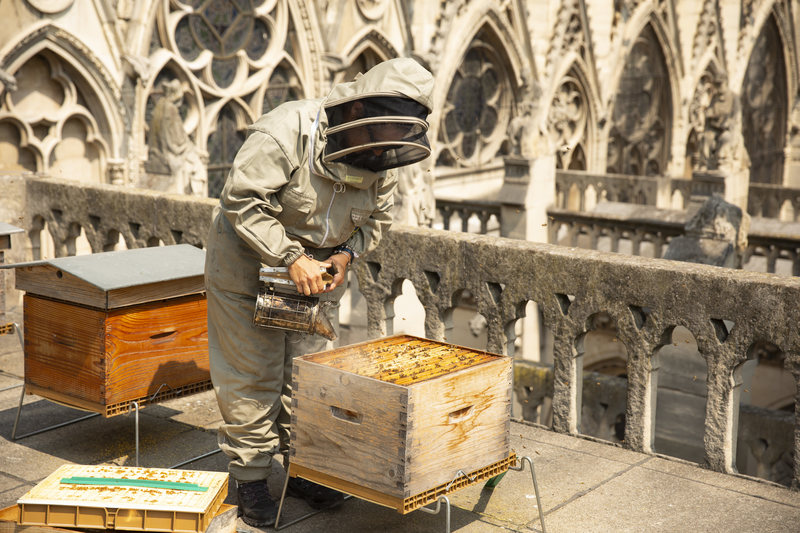THE STORY OF JEAN PAUCTON, the Parisian beekeeper, reads like a cross between a children’s book and an urban legend. It starts in the 1980s when the novice beekeeper—who also happens to be the property master for the famed Opéra Garnier—gets his first beekeeping kit. Surprised to learn that the bees can only be kept alive in a sealed hive for 48 hours, he realizes he’s going to have to find temporary accommodations for them until he can drive them to their intended home, his country house outside Paris.
Then, a colleague of Paucton’s, who had apparently been raising trout inside the Opéra’s famed reservoir, recommended he keep the bees on the building’s roof. There, the hive could be opened and the bees would be free to buzz around without hurting anyone. Paucton did, and he soon became a preeminent figure of the French beekeeping set, selling his homemade honey in the theater’s gift shop alongside souvenir keychains and recordings of “Carmen.” Although he packed up his Opéra rooftop hives in 2013, he seems to have helped make beekeeping on the roofs of Paris landmarks a bit of a thing.
Since then, Parisian beekeepers, or apiculteurs, have quietly kept hundreds of hives on the rooftops of some of the most famous buildings in Paris—often without the general public knowing anything about it. The Opéra Garnier, the Musée d’Orsay, the École Militaire, Notre Dame, the Grand Palais, and the Institut de France are just a handful of major monuments where area beekeepers raise their colonies. Privately owned buildings, such as the famed jewelry store Boucheron and La Tour d’Argent (the restaurant that claims to have introduced the fork to the French), also allow beekeepers to practice their métier, or job, on their roofs.
“Each site is different,” Audric de Campeau, a beekeeper of Le Miel de Paris (The Honey of Paris) explains in an email. “For most of them, mostly at the beginning, I just approached them and asked. For some of them I just have a handshake, for some others, a contract.” That said, the growing practice is not without its obstacles. The more popular beekeeping becomes, the more regulated it gets, and modern-day urban beekeepers are encountering old-fashioned bureaucracy.
As many of the marquee hives are situated on publicly owned rooftops, paperwork and red tape are becoming a serious nuisance, if not an outright deterrent for other beekeepers to join the fold. “It is much faster and easier to deal with private companies, who in addition often buy crops made on their establishment,” writes Bruno Petit, of Un Apiculteur Près Chez Vous (A Beekeeper Near You). “The public sector has only disadvantages.” That said, beekeeping is unquestionably on the upswing. According to Mathilde Wadoux, a PR representative for one of these beekeeping landmarks, the Grand Palais, there were approximately 300 hives in Paris at the start of this decade, while there are over 700 today.

But people’s eagerness to become urban beekeepers has also posed its own set of problems. “Certain districts of Paris and Montreuil are totally saturated in hives,” Petit adds. “This represents a risk of famine for the hives of these neighborhoods. The flora is no longer sufficient to feed [them].”
And then there’s the question of the bees themselves. Petit recalls how some of his fellow beekeepers were asked to remove hives from the roof of Fouquet’s, one of the city’s most famous restaurants, when their bees started drinking out of the flower vases adorning dining tables. Petit says he was asked by the Pasteur Institute to take his bees off a roof when they were found drinking stagnant water. Surprisingly, pollution isn’t an issue for Parisian beekeepers and, as Petit notes, air pollution doesn’t appear to affect urban honey’s quality. “We had hives on the roofs of two Monoprix stores in Paris,” he adds. “For each crop (over a period of three years), they analyzed about 30 pollutants and found nothing abnormal in the honey.”
Urban bees tend to be overachievers, producing higher honey yields than their rural counterparts. This is thought to be due to the fact that Parisian bees feed mostly on window box flowers, apartment terrace foliage, and flora in local parks. That means they’re not privy to the same neonicotinoid pesticides that their country cousins have been exposed to for years. Another factor is the city temperature, which tends to run slightly higher than surrounding rural areas.
True to form, Paris also offers its bees an exceptional variety of meal options, which greatly contributes to the increase in production. “The difference in yield comes mainly from the floral diversity in Paris,” Petit says. “Orange trees, jasmine, and other exotic plants can be found on the Paris terraces.” That diversity is also said to be responsible for Paris-produced honey’s unusual taste, which people have likened to cherry and bubble gum.

Unfortunately, while the yields are high, so are the prices. Although Parisian bees are more prolific honey producers, there are fewer of them than in the country. Which means that city honey can run about 122 Euros per kilogram, or approximately $65 per pound. In comparison, the average cost of high-quality honey produced in the country goes for about 23 to 50 Euros per kilogram (or around $12 to $23 per pound).
In recent years, city honey has gone from being a gift shop novelty to engrained in Parisian culture, a phenomenon that can be traced in its acceptance by the town’s notoriously revered and discerning dining rooms. De Campeau has worked with the likes of Guy Savoy and Thierry Marx, and in 2016, Michelin-starred chef Jérôme Banctel started incorporating his honey in the dishes he serves at the restaurants of La Réserve hotel. “Parisians love more and more to buy local,” de Campeau says. “And the honey is really delicious, it’s not a marketing thing … [it’s] a real prestigious recognition of our work.”
This acceptance is no small feat in a city that boasts entire supermarket aisles devoted to honey. Visitors to Le Bon Marché’s La Grande Épicerie Paris food hall, a store that is to food what a showroom is to cars, can now find local honey varieties on the shelves. The department store Au Printemps installed hives on their roofs last year and plans to sell its honey in Printemps du Goût, their new gastronomy department dedicated to French food products.

The craze comes full circle, given that the bee has been a symbol of France since Napoleon adopted it as his personal emblem. The tiny insect adorns everything from the façade of the Musée de Louvre to the perfume bottles of Guerlain, a storied French perfume house that started a “Bee University” conference in 2017 to discuss declining bee populations and potential solutions. Now, thanks to some very dedicated people, Parisians have come to value the honey as much as the iconic insect that makes it.


